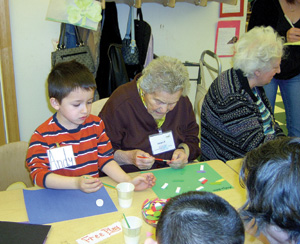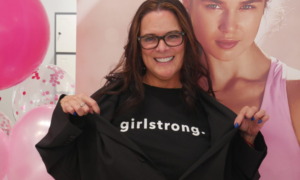At the Mt. Kisco Day Care Center in Westchester, N.Y., youth in the after-school program often prepare healthy snacks alongside senior citizens. One afternoon, Program Director Dawn Meyerski recalls, bags of trail mix inspired conversation about camping, with the seniors telling stories about wilderness trips of decades ago. Chatter filled the room as the youths and elders discovered their shared interest in a fun pastime.
 Such interaction is a regular part of each day at the center. Aside from serving 3- to 12-year-olds, the center rents part of its 20,000-square-foot building to “My Second Home,” a senior day care program – thus creating an IGSS, or “Intergenerational Shared Site.”
Such interaction is a regular part of each day at the center. Aside from serving 3- to 12-year-olds, the center rents part of its 20,000-square-foot building to “My Second Home,” a senior day care program – thus creating an IGSS, or “Intergenerational Shared Site.”
Intergenerational programs are proliferating. Beyond the “Harold and Maude” cliché of an older adult offering timeless wisdom to help a troubled youth exists a wide range of sustained and structured programs, including gardening projects, substance abuse mentoring and intergenerational orchestras. Supporters say intergenerational programs help youth, seniors and their communities. Such programs certainly make sense in light of the projected growth of the nation’s youth and senior populations.
The number of youth under 18 is projected to grow from 73.3 million in 2004 to 85.7 million in 2030, according to the U.S. Census Bureau. During the same period, the bureau says, the number of people over 64 is projected to rise from 36.3 million to more than 70 million.
The nation is “waking up and smelling the demographics,” says Donna Butts, executive director of Generations United, a Washington-based public policy organization.
While intergenerational programs were introduced in the 1960s at the beginning of President Johnson’s War on Poverty, she says, they have grown significantly in recent years.
Butts sees a newfound imagination in intergenerational program planning around the world. She cites a program in Australia that pairs teenagers who are arrested for auto theft with elder bikers who teach them how to work on cars.
Impact
What has not grown as quickly is research and evaluation about the effects of intergenerational programs. “There is simply not enough of it,” said a comprehensive research review published last year. The report, “Making What Difference? How Intergenerational Programs Help Children and Families,” added that “the existing program design, evaluation, and research methods used are, in general, not sufficiently rigorous.”
There have been promising signs. A 1996 study of Across Ages, an intergenerational mentoring and substance abuse prevention program created at Temple University’s Center for Intergenerational Learning, indicated that the program can increase school attendance and performance, while lowering the risk of drug use. Youth participants also exhibited more positive attitudes toward school, the future and elders than did a comparison group of nonparticipants.
Last year’s review of research, conducted by researcher Valerie S. Kuehne and sponsored by the Annie E. Casey Foundation, found results in the following areas:
Health: Participants in Family Friends, which matches seniors with disabled youth, had fewer visits to doctors and improved self-esteem.
Academics: Several programs have shown promising results in improving reading and school attendance and keeping disadvantaged youth in school. In one case, school officials associated a program called Experience Corps with improvements in math, reading and language development, but “data were not found to support the reported findings.”
Attitudes: “While some studies have demonstrated that children’s attitudes toward older adults and/or aging generally improve after intergenerational program experiences, other studies report the opposite result.”
Gradually, the field “is getting far more sophisticated analysis, which is validating what we’re doing,” says Sally Newman, former executive director of Generations Together, an intergenerational studies program at the University of Pittsburgh.
Help
Intergenerational programs face the challenge of integrating two seemingly divergent populations that are often segregated – think of retirement communities – and that often harbor mutual misunderstandings and stereotypes.
Organizations like Generations United and Temple’s Center for Intergenerational Learning offer resources, including model program development, training and technical assistance, and research and evaluation materials. The field has its own scholarly publication, released quarterly, The Journal of Intergenerational Relationships. Newman is the editor.
Intergenerational programs often cost little to start and can tap numerous funding streams.
“Because we’re working with two different age groups,” there are more funding sources to explore, Butts says.
Federal departments that fund intergenerational programs include the Administration on Children, Youth and Families; the Substance Abuse and Mental Health Services Administration; the Department of Education; the Environmental Protection Agency; and the Administration on Aging. AmeriCorps and SeniorCorps have intergenerational options.
Community foundations have also been big supporters, Butts says.
Following on page 12 are examples of how several agencies carry out intergenerational programs.
|
Resources Center for Intergenerational Learning Generations Together Generations United International Consortium for Intergenerational Programs (ICIP) Journal of Intergenerational Relationships
|
HIP (Habitat Intergenerational Program)
Habitat Education Center and Wildlife Sanctuary
Belmont, Mass.
(617) 484-0117
The Approach: Located on the Massachusetts Audubon Society’s 87-acre Habitat Sanctuary six miles northwest of downtown Boston, HIP promotes environmental awareness and conservation through education and community service.
The volunteer program links people of all ages, “dispelling myths about how the young and old ‘should’ act,” says HIP Coordinator Phyl Solomon.
Activities include cleaning trails and gardens, studying and sampling herbs, controlling the spread of invasive plants, taking bird walks and celebrating Earth Day.
Groups meet for various amounts of time, depending on the scope and size of their projects. For instance, the Pulling Partners program, which maintains trails and rejuvenates Habitat’s Weeks Pond, meets once a week after school. The Trail Days events convene for one day in the spring and the fall.
HIP encourages students to fulfill their 20 required hours of community service by participating in HIP projects.
History and Organization: In the fall of 1997, Solomon left a 35-year career in health care (mostly as a speech pathologist) with two goals: “Teach again, and find a way to link generations together in environmental service.” After growing up in an outdoors-oriented family and receiving training at Mass Audubon, she knew she wanted to devote her time to her lifelong passion for the outdoors.
With support from the director of Mass Habitat, she contacted nearby Chenery Middle School, where sixth-grade students are required to complete 20 hours of community service per year. A fall Trails Day was the pilot program to get the sanctuary ready for winter.
“About 35 people of all ages gathered to do community service,” Solomon recalls. “We chipped trails, cleared brush, raked leaves, talked, laughed, made new friends and had fun.”
A 12-person multigenerational steering committee, including youths and seniors, created the name, mission statement and structure for HIP.
Youth Served: During the 10 months per year that the program runs, Solomon estimates that each week 15 seniors and youth participate in HIP. In addition, the two Trail Days each attracts 50 to 60 participants, the annual Earth Day celebration draws about 150, and weeklong workshops draw from five to 20. Usually, more youth than seniors participate in HIP, Solomon says.
Staff: Solomon and other volunteers. No one receives financial compensation.
Funding: The program costs very little to operate. Expenditures include publicity for the program and books for the Habitat Library.
Grants from local foundations have included $5,000 from the Pappas Foundation to get the program through its first year; $9,700 from the Belmont Foundation for Education for a courtyard garden project with Chenery Middle School, and $1,500 from Great Adventures for community service outreach. An annual herb sale brings in approximately $1,500.
Indicators of Success: Recognitions have included the Fran Pratt Award (2003) from the Massachusetts Intergenerational Network (MIN) to honor a program that best exemplifies vision, leadership and service to the intergenerational movement; being featured in “Generations United for Environmental Awareness and Action” (2004), published by Generations United and Penn State University’s Cooperative Extension Service; and a National Wildlife Federation certificate of achievement (2005).
Solomon has spoken at a Massachusetts Council on Aging conference and at Audubon sanctuaries about the benefit of using intergenerational activities for environmental stewardship.
Computer Pals
Intergenerational Innovations
Seattle, Wash.
(206) 525-8181
www.intergenerate.org
The Approach: A volunteer-driven program that empowers middle and high school students by having them serve as tutors instructing elders on the basics of computer and Internet use.
Computer Pals is one of eight intergenerational program models coordinated by the Seattle-based Intergenerational Innovations, which unites youth and elders in service to each other and their communities. Since 1994, Computer Pals programs have been implemented at 36 sites in Seattle.
Computer Pals programs are developed and coordinated by AmeriCorps members. Programs run from four weeks to three months and are conducted in group settings.
For example, the program at Urban Impact, a faith-based community center, pairs one youth with one or two seniors for two hours per week for four weeks. Led by AmeriCorps member Alece Kaplan, the program recruits senior participants from area churches and through the nonprofit gym at Urban Impact, which offers senior programs. Youth interest is attracted through online Web postings, such as the United Way Volunteer Match or Craig’s List, an online network of urban communities featuring free classifieds. Kaplan also tries to target home-schooled youth.
Intergenerational Innovations provides the “Computer Power Learning System” curriculum, including a tutor manual for youth and a learner’s workbook for the elder participants.
History and Organization: Computer Pals was piloted by Intergenerational Innovations in 1994, and partnered with Washington Service Corps in 1997. The program at Urban Impact started last fall, with courses held weekly.
Youth Served: Since 1994, between 800 and 1,000 youth have taken part in Computer Pals, says Jerrine Regester, director of Intergenerational Innovations. About two-thirds of them have been youth who took part only in an e-pal relationship with a senior. Each year, about 50 Computer Pals programs are held at approximately 10 sites, with one to five youths serving at each site, Regester says.
Staff: One AmeriCorps member serves each site as the primary coordinator. Someone might also be specifically serving the elders through such tasks as coordinating transportation. Intergenerational Innovations is run by three staff members.
Funding: The most expensive part of running Computer Pals, Regester says, is “paying AmeriCorps members,” who get $3,000 to $10,000 each for a little more than 10 months of work. (Computer Pals, however, takes up a small part of their time at the agencies.) Intergen-erational Innovations pays an additional $2,000 to each AmeriCorps member through a grant from the Corporation for National and Community Service.
Computer Pals costs almost nothing to operate. Intergenerational Innovations seeks out locations where a computer lab exists, such as Urban Impact. Each site is given a $50 budget for every program, but that is “rarely used,” Regester says.
Indicators of Success: Participants take pre- and post-program surveys, Regester says. She says that surveys from the first and second quarters of the current program year (2005-2006) showed that 85 percent of senior participants improved their technical vocabulary and word processing skills. Among youth, 90 percent said they believed they contributed to their communities through the program, and 85 percent said they wanted to work with elders again.
Community of Mt. Kisco
Mount Kisco Day Care Center
Mt. Kisco, N.Y.
(914) 241-2135
www.mkdcc.org
The Approach: This intergenerational community is drawn from two nonprofits that share a building: the Mount Kisco Day Care Center (MKDCC) and the My Second Home adult day program. Each day, about 140 children take part in programs with the 50 seniors at My Second Home. For example, youth go to the senior section for arts and crafts, while seniors go to the youth section for light exercise.
Youth and seniors regularly participate in “Edible Education,” an on-site garden project that teaches them to cultivate crops and plants, to harvest food that is used to make meals at the facility, and to practice healthy nutritional habits. The goods are also sold at community farmers markets.
Activities such as fishing and theater trips allow youth and seniors to interact off-site and on the weekends and evenings. The biggest value in the arrangement, says Dawn Meyerski, the program director, comes from ongoing and spontaneous “relationship building” among youth and seniors.
History and Organization: MKDCC has been providing child care since 1971. For most of that time, the program operated in the basements of local churches. In 1998, an anonymous donor offered a plot of land to MKDCC on the condition that it develop the space to provide both child and elder care.
A grass-roots campaign raised $7 million to fund a building and the various programs. In May 2002, the day care and senior programs moved into the new space, a 20,000-square-foot, ranch-style building surrounding a large courtyard. MKDCC owns the building and rents space to My Second Home.
Youth Served: About 140 children (ages 3 through 12) come to MKDCC each day. That includes day care and after-school services.
MKDCC says half the youth qualify for county subsidies from federal Title XX block grants that fund services for youth from households with annual incomes under $30,000.
Staff: About 30 teachers in MKDCC, plus a staff for the seniors. The after-school program has one head teacher and four assistants.
Funding: Fifty-two percent of MKDCC’s income comes from parents’ fees, while 14 percent comes from individual contributions, 13 percent from foundation grants, 13 percent from government funding (such as the state’s Child and Adult Care Food Program) and 8 percent from rental income. For participants, the toddler program costs $1,455 per month, the preschool program costs $1,085 per month, and the school-age (after-school) program costs $525 per month.
Indicators of Success: No evaluations of the intergenerational program have been conducted. Meyerski cites MKDCC’s enrollment – it has a waiting list – as evidence of its success.
Jump Across Ages
Bridges … A Community Support System
Milford, Conn.
(203) 878-6365
www.bridgesmilford.org
The Approach: A nationally recognized intergenerational mentoring approach to substance abuse prevention, Across Ages targets middle school youth. At the program’s core is a special relationship between an older adult mentor (age 45 and above) and a youth who meet regularly on their own for a year. The program has been replicated at more than 30 sites in 17 states. (http://templecil.org/Acrossageshome.htm.)
Bridges, a comprehensive mental health and addiction services agency, began its Across Ages program in 1999. Each spring, Bridges hires liaisons to find youth at three middle schools who have behavioral and/or social problems that might be addressed by Across Ages. Twenty fifth- and sixth-graders are asked to participate for one year.
Beginning in July, participants take part in a four-week summer camp that Dawn Roy, coordinator of Adolescent Addiction and Prevention Services at Bridges, describes as “therapeutic.” In addition to standard outdoor activities, the camp, staffed by four licensed clinical social workers, has a mental health and behavioral component.
At the end of August, a series of events, such as “Mentor/Mentee Mingle,” help staff and participants pinpoint effective matches. During the school year, youth and mentors meet once a week for at least two hours for such activities as sports, games and shopping. They perform volunteer service within the community at least once a month. The youth are required to attend weekly life skills’ classes led by Bridges’ staff at their schools. The classes focus on conflict resolution and problem-solving. Family involvement is a key component of the program.
History and Organization: The Across Ages model was developed in 1991 by Andrea Taylor at Temple University’s Center for Intergenerational Learning. In 1999, the Connecticut Department of Mental Health and Addiction Services awarded a grant to Bridges to implement the program.
Youth Served: Since its inception, 175 middle school youth have participated.
Staff: Four full-time Bridges staff members are involved in Across Ages. Two split the main position, Across Ages specialist, which involves the bulk of the front-line work. There is also a supervisor, and Roy oversees the entire program. A “mentor recruiter” conducts outreach for volunteers. “Finding mentors – especially males – is always a challenge,” Roy says.
The adults and youth arrange their weekly activities, and the adults report those activities to the staff.
Funding: Bridges estimates that each match costs about $3,000 per year. In each of the program’s first three years, Bridges received $125,000 from the Connecticut Department of Health and Addiction Services. For each of the past three years, the program has been funded by a Juvenile Mentoring Program (“JUMP”) grant of $75,000 from the U.S. Office of Juvenile Justice and Delinquency Prevention. Because the federal grant was smaller than the state grant, Roy says, Bridges has scaled back some activities and sought funds from the city, state and private donors. The JUMP grant will end in October.
Indicators of Success: Across Ages was designated a model program by the U.S. Substance Abuse and Mental Health Services Administration and an Approved Model Project by the U.S. Department of Education, and in 1998, it was named one of the top 25 programs contributing to positive youth development by the U.S. Department of Health and Human Services.































